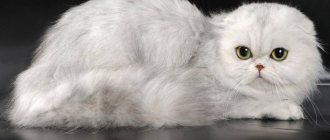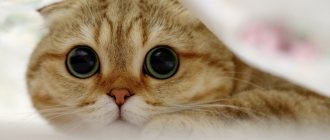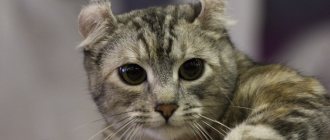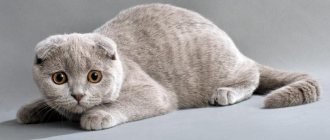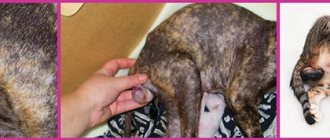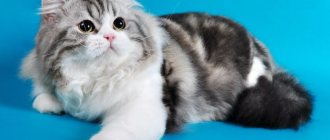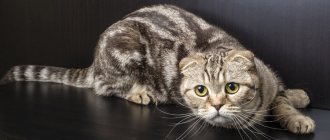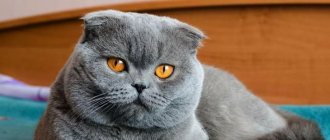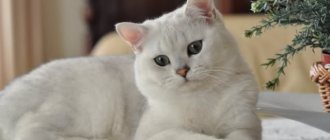The peculiarity of the Scottish Fold cat lies in the shape of its ears, which is not characteristic of other cats; it was once considered a defect, greatly transformed the animal and became the impetus for the creation of a new breed. It was formed with the participation of British and American Shorthair cats.
Not all world organizations enthusiastically accepted the breed with such non-standard ears. Only the CFA and WCF recognized Scottish Fold cats as a test breed in 1974, and four years later, at an elite exhibition in the USA, animals of this breed were met with rave reviews from felinologists and ordinary spectators. Since then, these charming cats began to fully participate in various types of exhibitions.
Breed varieties:
- Scottish Straights have a short coat and straight ears;
- Scottish Fold - short-haired with drooping ears;
- Highland Folds have long fur and ears close to the head.
- Highland Straights are long-haired with straight ears.
In addition to their unusual appearance, Scottish cats also have behavioral characteristics. They love to stand in a column on their hind legs. This is done not to attract attention or to see something better, but to warm up the spine. Another feature is their fear of heights, so they definitely won’t climb on cabinets or hang on curtains; these cats choose more aristocratic methods for their entertainment.
Description of breed standards:
- the body is of medium size, well-developed muscles, the maximum weight of a female is 4-5 kg, a male is 8-10 kg;
- the neck is short and strong;
- the legs are massive, the paws are oval-shaped;
- the tail is short and wide, tapering towards the tip;
- the head is spherical in shape with large plump cheeks, a massive chin and a flattened, humped nose;
- the ears are small, adjacent to the head, rounded at the ends;
- the eyes are large and set wide apart;
- The fur is thick and plush.
Kittens are born with straight ears. Only when they reach the age of 4-5 months can they change their shape and lie on their heads. The shape of their pressing to the head can also be different. Single, double or even triple folding of the ears stands out. The most valuable and expensive of all is the Scottish Fold cat, which has a triple fold of ears that fit snugly to the head, following its contour. Kittens whose ears have not drooped by the time they reach a certain age remain with straight ears for the rest of their lives. The pattern of this process has not yet been clarified, so the number of Scottish Folds in a litter is unpredictable.
What to feed a Scottish cat
What to prefer for feeding a purebred cat - dry food or natural products? Even veterinarians have not yet come to a consensus, so you will have to choose for yourself. If there is absolutely not enough time, then it is better to turn to ready-made food:
- Economy class - contains animal by-products, preservatives, flavor enhancers and food additives. One of the advantages is the low price.
- Commercial food also contains by-products, but of better quality, and the packaging states that the food helps prevent cat diseases.
- Premium class is the most expensive type of food, made from natural meat and cereals. It contains almost all vitamins and minerals. The cost of such food is high.
What else should you feed your Scottish cat? Canned food is also perfect for animals of this breed, but you need to know that such food can only be given at room temperature, and an open can can be stored for no more than 3 days. If you have a little more time to care for your animal, try a mixed diet: take good dry food as a base, and milk, fish and other products for complementary feeding.
Character and temperament
All varieties of the breed, from black straight cats to the more common gray fold-eared Scottish cats, are characterized by the same character traits.
- They are all kind and affectionate - the Scots are not characterized by aggression and rancor.
- These cats are calm and balanced; natural arousal is recorded only during sexual activity or in the late stages of pregnancy.
- Sociability and loyalty to family members and pets are at the highest end of the measurement scale.
- Good learning ability - Scots are able to remember acquired knowledge for a long time.
- Unpretentiousness in food and living conditions.
Scottish Folds love active games, enjoy general walks and are always ready to keep a person company.
Description of the breed
The Scottish Straight cat has several distinctive features that can only characterize him. So, comparing the animal with the British, we can highlight several noticeable features:
- His head has a more rounded shape.
- The body is elongated, oblong, but looks more graceful. This is due to the fact that it has a reduced size.
- The Scottish Straight weighs much less - only 3-5 kg, depending on what gender it belongs to. Naturally, boys are characterized by greater weight.
- They are characterized by high plasticity.
- Playful and resilient.
It is important to ensure that the animal does not need anything. After all, his life expectancy mainly depends on several factors: feeding, health, habitat, etc.
It is also recommended to contact only trusted clinics to vaccinate your pet. If they are expired, this may lead to his death. By the way, the Scottish straight-eared cat is very difficult to tolerate any injections. It may take 2-3 days or even a week for the body to recover.
Cat for mating
The Scottish Fold cat needs a male after a year. In general, puberty in Scots occurs at seven or eight months, sometimes a little earlier. At the same time, experts recommend carrying out the first mating no earlier than a year. Early mating often leads to curvature of the spine, which entails a difficult birth, during which the death of both the offspring and the cat is quite likely. Sometimes, after early mating, the development of the embryo may stop. Due to sexual exhaustion, cats become much less fertile.
The cat to be bred must be carefully selected. The Scottish Fold breed has a peculiarity: the male covers the female up to ten times in one hour, but for fertilization to be successful, the animals must be kept together for at least three days. A purebred Scottish Fold cat can cover one cat within 2 weeks.
For mating, it is necessary to use Scottish Straight cats, cats of the same breed, but with straight rather than tucked ears. Do not breed two such individuals, since their offspring are guaranteed to exhibit congenital defects in the paws and spine. In addition, such kittens are characterized by a general weakening of the body.
Character of black Scottish cats
The character of black Scottish cats can be different, it does not depend on the color. There is evidence based on a survey of owners that black cats are active, stress-resistant, phlegmatic, intelligent, friendly and stubborn. Rumor also attributes to them good ability to catch mice. However, from a scientific point of view, owner surveys alone are not sufficient to draw such conclusions. After all, the answers are very subjective.
It has not yet been scientifically proven that genes for black color are linked to genes for any character traits. And such a quality as the ability to catch mice is generally determined not by color, but by whether the mother cat taught this craft to her babies in childhood.
As for the vaunted tolerance and reduced aggressiveness of black cats, scientists have already proven that this quality is directly related to the size of the adrenal glands. Thus, modern domestic cats have smaller adrenal glands than their wild ancestors, so they are less aggressive.
Thus, black cats, if they were less aggressive, should have smaller adrenal glands than the average domestic cat. But their adrenal glands are no different. Thus, reduced aggression is a myth. But black cats do not have increased aggressiveness: there are different individuals among them.
Let us repeat once again: there have been no reliable studies proving the connection of the color gene with the gene of any character traits in cats.
Folk beliefs about the black cat
From time immemorial, people have seen something mystical in black cats, considered them animals of magicians, and some attributed bad qualities to them and came up with signs like “expect trouble if a black cat crosses the road.” It is not surprising that even Bulgakov’s devilish cat Behemoth in “The Master and Margarita” was black.
Astrologers also came up with their own description of black cats. So, they believe, black Capricorn cats are under the influence of the planet of loneliness Saturn, which means that it is better not for single women who want to find a mate to have them. And, for example, a black cat born under the sign of Pisces will give its owner the ability to see prophetic dreams and perform magical rituals.
Esotericists who believe in the supernatural believe that black cats provide protection from negative energy
Whether this is true or not really doesn’t matter. If you believe in this, then the protection will work, because then you will radiate confidence - and all adversity will bypass
Story
There is every reason to believe that the ancestors of our today's hero were Roman cats. Together with the legionnaires, they arrived on ships in Great Britain and conquered this country. Fold-eared Britons in the form in which we fell in love with these cute creatures appeared only in the nineteenth century. It was during this period that many experiments were carried out to create new breeds or change existing ones.
In order to get such amazing plush fur , the idea arose to cross a Scottish cat with a Persian cat. The result is known to you and me. Fans of the cat family, especially furry representatives, have probably already admired the lovely creature. But why did the black color appear? There are reasons for this too. The fact is that the British believe that it is black cats that attract good luck to the house.
Scottish Fold cat: character
If you decide to have a pet of this breed, you will have to accept it as a full member of the family. This animal is not suitable for the role of a pet ottoman.
What does a charming Scottish Fold require from you? First of all, love and care. However, make no mistake: cleaning the litter box and providing food for your pet will not make you friends. Love for your furry friend must be shown constantly. In any free minute, pet him, play and talk.
Scottish Fold kittens are very smart, so they will quickly respond to you. Let it be in your own cat language. And the adults will amaze you with their wisdom.
Scottish Folds designate one member of the family as their master. They are friends with him and obey him unconditionally. They follow him and take part in any business.
If your pet understands that he is bothering you with his pursuit, he will simply sit next to you and patiently wait for you to pay attention to him. The Scots rarely show bad sides of their character, they are very patient, and it seems that their patience is limitless
The Scottish Fold cat, whose character could be called angelic, easily learns to use the litter box; by nature, he is not a dirty trickster. He will not tear up furniture or hang from curtains just because he has nothing better to do.
If you notice that your pet is doing something inappropriate, then know that this is just to attract your attention. For example, he knows very well that he should not climb onto the kitchen table.
But you haven’t stroked him for a long time, which means you need to draw attention to yourself in any way possible. Play with him, pet him, but don’t scold him (let alone hit him). He understands perfectly well that he did something wrong, he just felt very lonely.
Description of the breed of Scottish black fold cats
The black fold cat is a variety of the Scottish Fold breed.
The animal's head is round in shape, its forehead is flat, its ears are drooping. The coat is a solid black color. The average weight of an animal is about nine kilograms.
The ancestor of the Scottish Fold breed was the cat Susie. Which was born in a litter of a semi-wild cat, the father was unknown. For a long time, Susie caught mice and lived in a modest closet. Very soon the cat began to give birth. Mary Ross adopted one of these kittens.
Later, it was this lady, with the help of eminent breeders, who would develop the main algorithm for the birth of fold-eared kittens.
Now the Scottish Fold breed has become extremely popular all over the world. Many of our compatriots also liked kittens with fancy ears.
Currently, the Scottish Fold breed is extremely popular
Caring for black Scottish cats
Black cats are not easily soiled, so if the floors in your apartment suddenly become dirty, you won’t be able to see it from a black cat, unlike a white one.
You can comb a black cat with any comb or other device that does this well.
Cats are bathed with professional shampoos that enhance the black color and add shine. This is relevant, first of all, for show animals. However, if your pet does not participate in exhibitions, but you are very picky about its appearance, we also recommend purchasing a special professional shampoo. Moreover, it allows you to maintain the microbiome (microflora) of the cat’s skin in the desired form.
It is worth making sure that the cat receives enough vitamins and minerals from food - then the coat will shine. If a cat does not receive enough trace elements, in particular the amino acid tyrosine, which is involved in the synthesis of the eumelanin pigment (black pigment), the coat fades.
Tyrosine is contained in meat, so not only for health, but also for the quality of color, the basis of the Scottish cat’s diet should be this product. Otherwise, the fur will take on a reddish, rusty tint.
You should not allow your pet to be exposed to sunlight for long periods of time to prevent the fur from fading.
Genetics of black color
The black Scottish Fold cat, as well as the straight-eared cat, have a special gene that gives this coat color. This is a gene of the black series, which is designated by the letter B. But since there is always a pair of genes in the set, the black color gene can be presented in the homozygous state BB or in the heterozygous state, for example, Bb (a cat or cat that has a black color, but is a carrier chocolate color gene).
In order for a cat to be like a piece of coal, the B gene is not enough. In addition to it, the cat must also have the color density gene D (in the homozygous form DD or in the heterozygous form - Dd). If a cat has a set of genes not DD or Dd, but dd (d is a diluent gene), then it will force the color pigments inside the hairs to group differently - and the cat will be blue (gray), because gray is the same black, only diluted, or rather, regrouped differently.
There are a number of other genes that help either to form a solid black color, or to create other colors based on the black series gene. But this is the topic of a separate article devoted to genetics. Here we provide only basic knowledge.
Highland fold
The Scottish cat breed, as already mentioned, has several types. The Highland Fold is distinguished by a rounded, perfectly shaped head with a strong chin and a dome-shaped high forehead. The neck is powerful. The cat has well-developed cheeks, a wide and short nose. The transition from forehead to nose is smooth.
The ears are folded, lowered forward, and since the hair of these animals is long, it seems that they are not there. The eyes are large and round, set wide apart.
The body is compact. It should not be short, like the Persians and exotics. Excessive thickness, lack of mobility, and short legs are considered disqualifying defects. The toes are rounded, gathered into a dense pad.
The tail is of medium length, tapering towards the end, flexible. This Scottish Fold longhair cat has a very beautiful coat. The fur of these animals is soft and light, having a uniform texture, similar to silk to the touch. It is shorter on the shoulders, paws and muzzle.
Health
On average, representatives of this breed live 13-15 years and can boast of good health. There may be some genetic mutations, signs of which are already visible in infancy.
Cats of this breed, like their short-haired counterparts Scottish Folds, are bred with representatives of straight-eared Scottish cats (straight fold). If both parents are lop ears, various genetic abnormalities occur and the offspring are not viable.
The lop ear gene also determines the tendency of these cats to various problems with the musculoskeletal system. A predisposition to bone and joint diseases is indicated by:
- short tail, with curvatures, seals;
- protruding vertebrae of the skeleton;
- uneven, waddling or limping gait;
- lack of activity typical of kittens, isolation.
Otherwise, the Highland Fold is a fairly healthy breed. A cat may get cardiovascular diseases common to these animals, it may have kidney problems, tartar, and worms.
Most of them occur due to insufficient or improper care. The cat must be regularly taken to the veterinarian for a medical examination, vaccinated, given vitamin and mineral supplements, anthelmintic drugs, and treated with anti-tick and flea compounds. The pet needs to be fed properly and fully, its ears, teeth and eyes should be cleaned, and it should be regularly examined independently, then it will live a long and very happy life.
Features of color
Ancient cats had several color options. Felinologists associate this phenomenon with the natural need to camouflage during hunting. Later, when animals became domesticated and began to live next to humans, the number of color combinations increased due to interbreeding.
Eumelanin, a high-molecular pigment with a complex chemical formula and irregular structure, is responsible for the formation of the charcoal shade. As part of cat hair, it is represented by spherical granules that absorb the color spectrum as much as possible. They are evenly located along the entire length of the hair and color it from the root bulb to the very tip.
It is very difficult to get a beautiful black color in fold-eared cats. The color is traditionally “capricious” and often takes on extraneous shades. This is especially true for animals with thick undercoat. It becomes covered with reddish “rust” or piebald gray hair, which noticeably detracts from the spectacular appearance of the black coat.
Another problem in obtaining a pure black color in fold-eared cats is the presence of additional derivatives of the eumelanin pigment: brown and cinnamon (cinnamon). If the selection of partners for mating is incorrect, these shades affect the process of color formation.
In natural breeds, brown color is extremely rare, but Scots do not belong to the group of aboriginal cats and therefore have a very high risk of such a transformation.
But in its pure form, black eumelanin provides some benefits for a cat's appearance:
- The wool gains mechanical strength - the pigment strengthens the hair.
- Chemical treatment does not affect eumelanin; it is resistant to aggressive environmental influences and is not dissolved by organic compounds.
Genetics of black color
If, on the part of pigments, only one element (eumelanin) affects the color of black Scottish fold cats, then several components take part in genetic engineering.
- The main dominant gene for black color is B. In various combinations of alleles, it can turn into bb (chocolate color) or b1b1 (cinnamon color).
- The agouti gene in the dominant state A forms the pattern on the coat, and in the recessive state aa gives a solid color. For a black or black and white fold cat, this item usually takes the recessive form aa. Although the pattern is not visible on the main color, the white areas are characterized by a complete absence of pigment and also do not react to agouti. But for brown and cinnamon animals, gene A is very important.
- Tabby (T) is a pattern on the coat; it can take the form of stripes, spots, and ripples. Totally depends on the agouti.
- Gene D. In the dominant state, the color remains unchanged, and in the recessive state, dd lightens it by several tones. For example, in a Scottish fold black and white cat, the main color will be replaced by blue.
The genetic formula for the ideal solid black color in the Scots is expressed as follows -aaB-D- (no agouti/black/no bleaching).
Additional genetic “components” take part in the formation of bicolors (a combination of the main color and white).
- Option Ss – bicolor. Under normal conditions, the proportion of colors is approximately 30:70.
- Sisi combination – white spots (buttons, medallions).
- Van color – Sw. In this black and white version, the Scottish Fold cat is colored dark on the tail and in the ear area, while the rest of the coat remains light.
Eye color
The influence of coat color genes on eye color has not yet been established. Scientists believe that so-called polygenes complicate matters here. They give instructions simultaneously to several hereditary characteristics, both hidden and obvious. Eye color in cats falls precisely into this section.
The animal does not have any separate genetic instructions from the parental set of chromosomes, but from generation to generation it duplicates the same characteristics.
Black Scottish Fold cats traditionally have copper or honey-amber irises. Green color is also allowed in native breeds, but Scots do not belong to this group.
Description of appearance
The breed standards correspond to those of the Scottish Fold. In appearance, these cats resemble cute soft toys: they have fluffy, “cloudy” fur, so they look like slightly plump balls.
Varieties of Scots
However, the body of the Highland Fold is usually of medium size, fairly proportional, with well-developed muscles. Some individuals reach a weight of 8 kg, but usually they are small, about 4-5 kg. The legs are strong, not very long, the paws are rounded, and fur grows between the toes. The tail is very fluffy, should be straight and mobile, wide at the base, tapering to the tip. The length of the tail is ideally two-thirds the length of the cat's body.
A characteristic feature of the Highland Fold is its downturned, hanging ears. They can have from one to three folds.
The breed is distinguished by a large number of acceptable color varieties: cats can be one-color, two-color, any patterns or stripes on the coat are acceptable.
Highland Folds come in the following colors:
- monochromatic - the same shade evenly distributed throughout the body: blue, gray, red, chocolate, black, lilac;
- tortoiseshell – two colors evenly distributed over the body: red and black;
- bicolor or two-color - the cat is painted in two colors, the combinations can be very diverse;
- smoky (smoke) - the pigment is unevenly distributed along the length of the hair: at the base it is colorless, and at the tip it is black, this pigmentation of the coat creates an unusual and beautiful smoky color;
- color point - the whole body is covered with white hair, and on the nose, muzzle, ears, lower parts of the legs and tail the color is contrasting, darker;
- tabby (wild color) - the coat is colored in uniform stripes alternating lighter and darker shades, on the muzzle dark lines form the letter “M” on the forehead and around the eyes, giving them exceptional expressiveness (tabbies can be marbled, spotted, ticked);
- Calico is a combination of three colors: black, white and red, sometimes called “tortoiseshell and white.”
Kitten care
Caring for Scottish Fold kittens is easy. The coat does not require special care; it is enough to comb it once a week; it is enough to wash the eyes once every 5-7 days.
The only thing worth paying attention to is ear care. This issue should be treated with the utmost care.
It is the ears that are the calling card of this cat breed, but at the same time they are also a weak point.
Eye examination and cleaning
If your eyes are healthy, then there is no special need for rinsing, you just need to keep them clean. But if the eyes are inflamed, they should be washed 2-3 times a day; this can be done with plain water, a weak chamomile solution or a medicated solution. To do this, you should use a cotton swab or soft cloth. If the inflammation lasts more than a week, then you need to consult a specialist.
Ear cleaning
This procedure should be done two to three (more often) times a month. To clean, use a cotton swab slightly moistened with a special liquid. The procedure must be carried out carefully so as not to damage the auricle.
The presence of a thin brown crust in the ears is an alarming sign; it indicates the presence of ear mites. In this case, you cannot do without a visit to the veterinarian. The treatment will be long with the help of a special solution. If measures are taken in time, the prognosis is favorable.
Grooming
To keep your Scottish Fold kitten beautiful and well-groomed, you need to take care of its fur; it’s not at all difficult. To properly care for the coat, you should use a special brush or silicone glove. During the shedding period, it is recommended to comb it once a week, the rest of the time once every two weeks will be enough.
While at the dacha, you should pay special attention to this procedure, carefully examine the animal every day for ticks and other parasites.
Bathing, washing
Scottish fold kittens must be accustomed to water procedures from childhood. To do this, you need to gradually moisten them with a damp towel, and then give your pet a treat so that he develops a reflex that a bath is not scary. In the future, you can safely wash the kitten. Particularly active kittens are recommended to be protected in a special way before taking a bath. To do this, cover your ears with tampons. or you can simply cover them with your hands to prevent water from entering. Your eyes also need protection; you can even drip special protective oil into them, but this is not necessary.
When washing your Scottish Fold kitten, be sure to use cat shampoo, and then its coat will be healthy and shiny. The products are not suitable for humans, they will cause skin irritation and worsen the condition of the coat; in severe cases, dermatitis is possible.
Nail trimming
Very sharp, thin claws of a kitten should be trimmed with special clippers for small animals.
The advantage of such a tool is that they give a straight cut without splitting the claw - this is very important! When caring for a kitten's claws, only the very tip is removed. Under no circumstances should you damage a blood vessel, this will cause severe pain and can lead to the most negative consequences.
In this case, a simple rule applies: it is better to cut off too little than too much.
Nutrition
Fold-eared cats are unpretentious to food, but you still shouldn’t feed them leftover food from your table. The ideal food for this breed is premium dry food. It is best to purchase such food in specialized stores or veterinary pharmacies.
If the owners do not have the opportunity to buy expensive food for their pets, then you can prepare food for them yourself. It is better to take poultry or lean beef as a basis and give it in the form of minced meat. Buckwheat, rice or oatmeal porridge is best as a side dish.
If you prepare your pet’s food yourself, do not forget to add vitamin and mineral complexes with a high calcium content to the diet.
Scots are unpretentious in food, but all cats of this breed require additional vitamins
The kitten’s diet is different in that it should be fed at least 5-6 times a day in small portions. If the baby’s diet consists of special food, then it is best to choose a liquid option in the form of jelly with pieces of meat or pate. There should always be water in the bowl and change every day.
